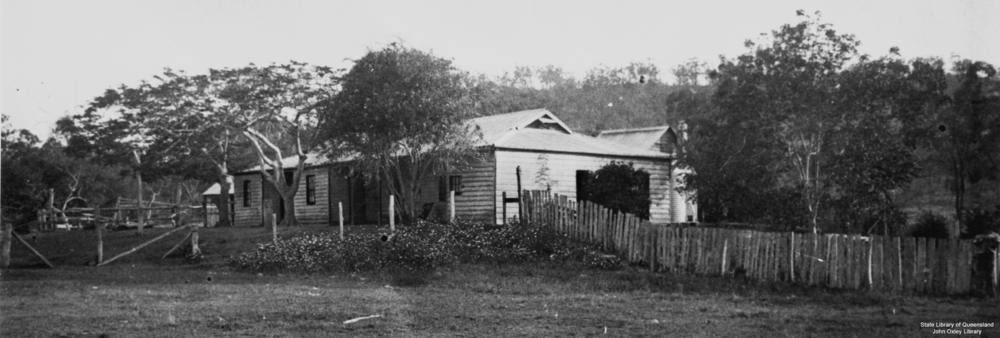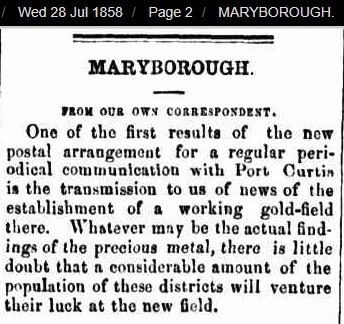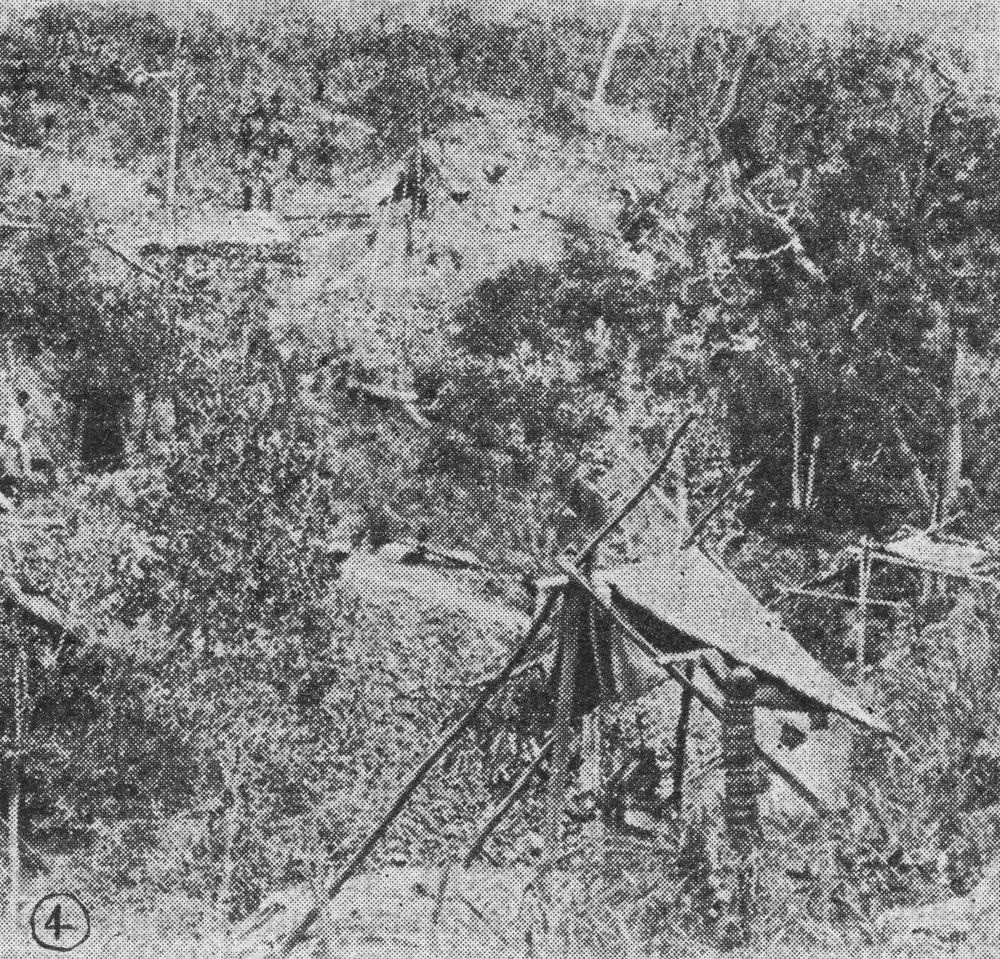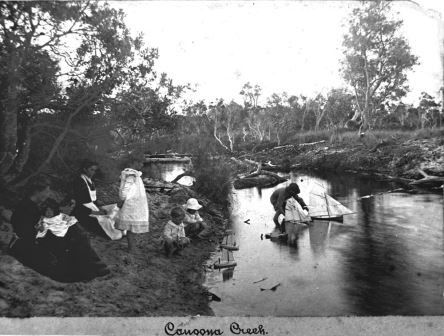Gold Fever – “The Canoona Delusion” near Rockhampton.
By Administrator | 25 October 2018
As a result of a research enquiry to the Ask Us Service, an interesting example of “gold fever” was uncovered in State Library of Queensland’s collections. This month marks the 160th anniversary of a remarkable occurrence in Queensland’s history – the Canoona gold rush. A short gold rush, over in two or so months, it nevertheless attracted thousands of people to leave urban jobs and try their luck in the north. Canoona is not remarkable for the amount of gold found, but rather for the social phenomenon inspired by “gold fever”.

Timber residence at Canoona Station, ca. 1910, State Library of Queensland, Neg. no. 116501, http://hdl.handle.net/10462/deriv/109623
Canoona is 40 km north-west of Rockhampton on the Fitzroy River and is named after the Canoona Pastoral Station. The gold fields were often referred to as the Fitzroy Fields or Canoona Fields. On 28th July 1858, it was reported that as a result of regular communications with Port Curtis (later Rockhampton), it had been learned that gold was found at Canoona and the scramble for wealth began (Moreton Bay Courier, 28 July 1858, p.2). A Mr W. Chapel was credited with the discovery. There were a number of alluvial gold fields in the Rockhampton region in later years, particularly at New Zealand gully but none attracted as much mania as Canoona.
By 21st August, a mail service was established between Rockhampton and the Canoona Gold Fields every fortnight. Letters flooded into the newspapers. On the 15th September, it was reported that one sample weighed 7 ounces and Captain Knight of the ship Waratah believed that the Fitzroy diggings “will be very productive”, after commenting that nearly all the male inhabitants of Maryborough had left to go to the diggings. Another newspaper correspondent reported that all the men were making 1 to 2 pounds per day, just sifting surface soil with a tin dish, and that all of the boat crew and the constables from Gladstone had gone to the diggings (Moreton Bay Courier, 15 September 1858, p.4).

Moreton Bay Courier, 15 September 1858, p.2
Trove, the National Digitised Newspaper database, illustrates the conditions at Canoona through the many letters published in all of the major daily newspapers in Australia. Some of the gold hunters were serial gold diggers – making their way from one gold field to the other. Hugo Wilhelm Du Rietz (1831-1908), born in Langas, Sweden, came to the Victorian gold rush in 1852, then went on to the Canoona gold rush in Queensland in 1858. He settled in Brisbane as a builder in 1862 and then ventured to the Gympie gold rush in 1867. It was reported that there were gold diggers from San Francisco and Mexico as well as all regions of Australia at Canoona and a description from one newspaper correspondent described his fellow travellers on the ship City of Sydney (375 in number) “as motley and perhaps as diversified an assortment as ever sailed out of any harbour…they ranged from filibusters…to urban clerks, ….swindlers, card sharps, gamblers and sly grog sellers”. (Lorna McDonald, 'The Rockhampton Delusion' A Brief History of the Canoona Rush, Queensland Heritage, Vol. 3 No. 10, p.32)
Reality struck the gold miners immediately upon arrival in their make shift tent city. In a small area where the original finds were made, “every atom of surface earth had been removed...by careful sweeping” (Sydney Morning Herald, 13 october 1858, p.5) leading one wit, a Ballarat gold mining veteran, to complain in his letter to the newspaper that he should have bought a broom to the diggings not a pick and shovel! Chinese miners were often successful where Europeans were not so, especially where it was an alluvial deposit. It was reported that a Chinese group, who had been at works from the opening of the field were said to have been holding 120 ounces in gold, whereas the number of European diggers holding gold was comparatively small.

Gold-diggings, New Zealand Gully, Cawarral district, ca 1897 , State Library of Queensland, Neg. no. 20388, http://hdl.handle.net/10462/deriv/205206By October, miners were leaving in droves, as quickly as they had arrived, according to the newspaper reports. On the 29th September, it was reported that miners were already beginning to grumble and a meeting held that evening created panic throughout the diggings as miners were told that there was little gold left. Within a few days, it was reported that there were 3000 people encamped on the Fitzroy River in Rockhampton, with few provisions. There was little water as it had not rained in nine months and it was very hot. William Lloyd wrote in the Sydney newspaper on the 1st October that “Men, women and children were lying on the ground in a state of destitution with only a blanket or sheet to cover them…there was no food.” John Hux reported on the 12th October that there were not more than 10 bags of flour on the entire diggings and that Ramsay’s Station, on route to the diggings, had nothing but mutton and beef. (Sydney Morning Herald, 13 October 1858, p.5)
Starvation faced many, and a great number of the miners could not afford their fare back to Sydney or Melbourne, until the shipping owners offered the grumbling miners the opportunity to return for half fare. On October 12th, it was reported that there were 1500 passengers on 11 ships bound for, or arriving in Rockhampton. Shipping agents operating out of a tent were set upon and ships captains became the unwitting recipients of abuse and blame.
State Library has a number of published histories about the early days of Rockhampton. Lorna McDonald wrote in her article “'The Rockhampton Delusion' A Brief History of the Canoona Rush” that in fact, between 1st October and mid-November 1858, seventy three ships cast anchor in Keppel Bay…landing more than 8,000 passengers (Lorna McDonald, p.32).
The “Canoona Delusion” altered the course of many lives. Some men found work locally, on the Archer’s property and other pastoral stations and stayed in the Rockhampton district. Many could not afford even the half price fare back to Sydney. Those who did make it back had other issues to contend with – one man named James Jones, wrote to Rev Dunmore Lang pointing out that he had sold everything he possessed, despite the fact that he had a wife and five children and since returning to Sydney, could not find regular work. "The family were destitute!" (Lorna McDonald, p.33)
In Port Curtis, the crisis had passed by December, and the new town of Rockhampton was established as a Port of Entry, with a customs house and a surveyed township. Canoona settled back into a quiet existence as a pastoral area with little reference to the delusion and mania that once made it the talk of all in the colonies.

Canoona Creek, State Library of Queensland, Neg. no. 170526, https://hdl.handle.net/10462/deriv/106425Christina Ealing-Godbold
Research Librarian
Visitor & Information Services
More Information
Queensland Heritage, https://espace.library.uq.edu.au/view/UQ:246264
Trove digitised newspapers - https://trove.nla.gov.au/newspaper/
Ask Us - /services/ask-us
Comments
Your email address will not be published.
We welcome relevant, respectful comments.